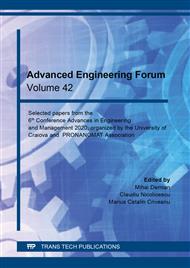[1]
ASM Handbook Vol.7 Powder Metal Technologies and Applications, ASM, Materials Park OH, (1998).
Google Scholar
[2]
H. Danninger, R. de Oro Calderon, C.Gierl-Mayer, Powder Metallurgy and Sintered Materials, in: Ullmann's Encyclopaedia of Industrial Chemistry, Wiley Online Library, 2017, https://doi.org/10.1002/14356007.a22_105.pub2.
DOI: 10.1002/14356007.a22_105.pub2
Google Scholar
[3]
S. Geroldinger et al., Properties and microstructures of sintered steels alloyed with Cr, Mn and Si by the masteralloy route, Proc EuroPM2020 Virtual Congress, EPMA, Chantilly (2020) paper no. 4845989.
Google Scholar
[4]
D. Eylon, Titanium P/M Products, in: Metals Handbook Vol.2, 10th Ed., ASM, Materials Park OH, 1990, pp.647-660.
Google Scholar
[5]
M. Mühlburger, P. Paschen, Flüssigphasensintern von AlZnMgCu-Legierungen, Z. Metallkunde 84 (1993) pp.346-350 (in German).
DOI: 10.1515/ijmr-1993-840512
Google Scholar
[6]
L. Albano-Müller, F. Thümmler, G. Zapf, High-Strength Sintered Iron-Base Alloys by using Transition Metal Carbides, Powder Metallurgy 16 (1973) pp.236-256.
DOI: 10.1179/pom.1973.16.32.006
Google Scholar
[7]
G. Zapf. K. Dalal, Introduction of High Oxygen Affinity Elements Manganese, Chromium and Vanadium in the Powder Metallurgy of P/M Parts, Modern Developments in Powder Metallurgy 10 (1977) pp.129-152.
Google Scholar
[8]
G. Schlieper, F. Thümmler, High strength heat-treatable sintered steels containing manganese, chromium, vanadium and molybdenum, Powder Metall. Int. 11 (1979) pp.172-176.
Google Scholar
[9]
S. Banerjee et al., New Results in the Master Alloy Concept for High Strength Sintered Steels. Modern Developments in Powder Metallurgy 13 (1981) pp.143-157.
Google Scholar
[10]
A. J. Yule, J. J. Dunkley, Atomization of Melts, Clarendon Press, Oxford, (1994).
Google Scholar
[11]
P. Orth, A. Bouvier, R. Ratzi, H. Danninger, New Materials and Process Concepts for High-Loaded PM-Components: Mechanical Properties, New Alloying Systems. Proc. PM2004 Powder Metallurgy World Congress Vienna, H. Danninger, R. Ratzi eds; EPMA, Shrewsbury UK (2004) Vol.3, pp.307-312.
Google Scholar
[12]
Handbook of Chemistry and Physics, 67th Ed, CRC Press, Boca Raton FL, (1987).
Google Scholar
[13]
P. Engdahl, B. Lindqvist, J. Tengzelius, Fatigue behaviour of PM steels – material aspects, Proc. PM'90 World Congress, London, The Inst. Of Metals, London (1990) Vol.2, pp.144-154.
Google Scholar
[14]
W. B. James, What is Sinter Hardening? Proc. PM2 TEC '98 Las Vegas, MPIF, Princeton NJ (1998) https://www.gknpm.com/globalassets/downloads/hoeganaes/technical-library/technical-papers/test-papers/62.-what-is-sinter-hardening.pdf/.
Google Scholar
[15]
H. Danninger, Homogenization and pore formation during sintering with transient liquid phase. Powder Metall. Int. 20 No.1 (1988) pp.21-25.
Google Scholar
[16]
S. Banerjee, V. Gemenetzis, F. Thümmler, Liquid phase formation during sintering of low-alloy steels with carbide-base master alloy additions. Powder Metall. 23 No. 3 (1980) pp.126-129.
DOI: 10.1179/pom.1980.23.3.126
Google Scholar
[17]
C. Gierl-Mayer, J. Zbiral, H. Danninger, Enhanced Sintering of PM Steels by Addition of Fe-Ni-B Masteralloy, Proc. EuroPM2014 Salzburg, EPMA, Shrewsbury UK (2014) paper no.14066.
Google Scholar


